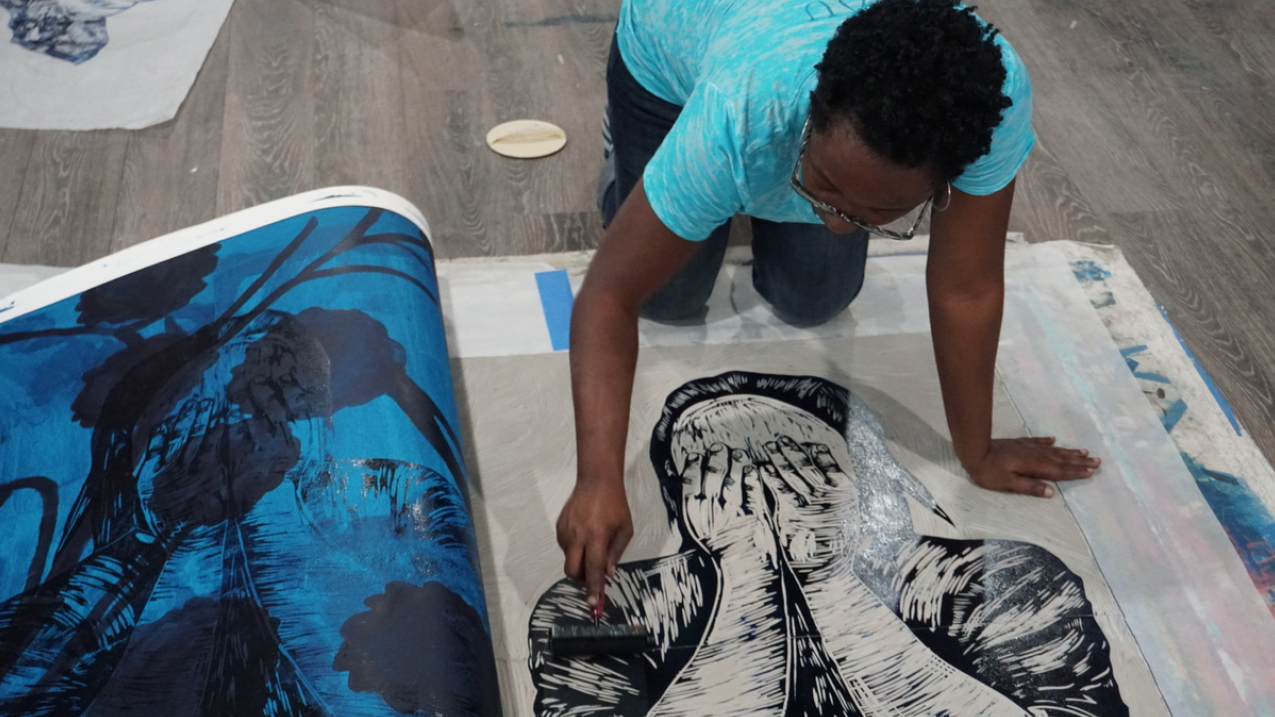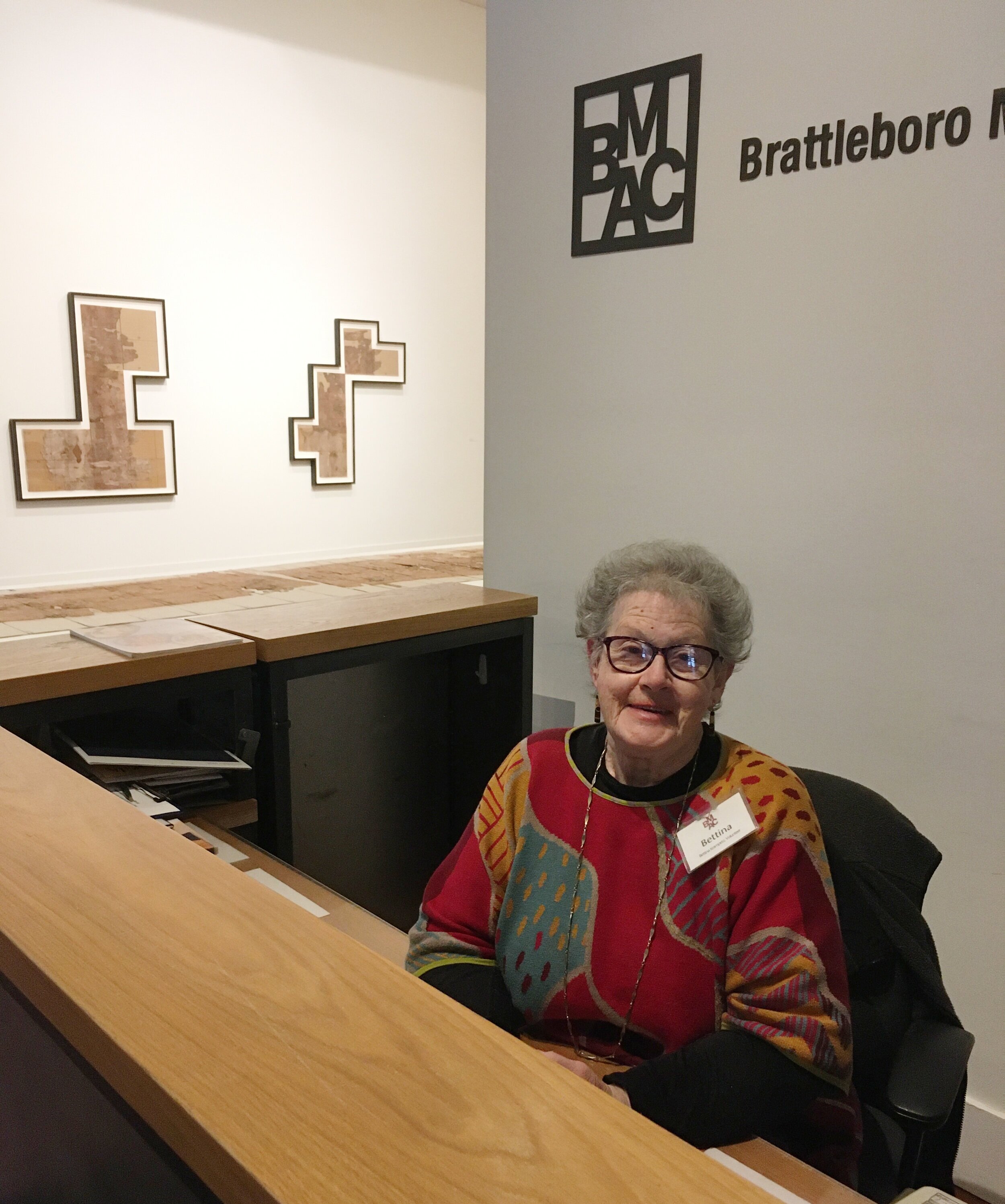“The work has always been personal”
Delita Martin’s “Between Worlds” is a year-long installation (on view through May 2022) in the large window bays across the front of the Brattleboro Museum & Art Center. Martin’s work reimagines the roles of Black women in the context of collective Black culture and African history. Her goal is to use images as a visual language to tell the stories of women who have often been marginalized.
Martin uses multiple techniques and media in her work, including relief and gelatin printmaking, charcoal and Conté drawing, hand-stitching, collaging, gold leaf, and acrylic painting. The prints on display at BMAC are digital reproductions of Martin’s original mixed media work.
The exhibit’s impact has been undeniable. In a South Florida Times article titled “Take a Black journey through Brattleboro, Vermont,” Dwight Brown writes:
For Black travelers who arrive [in Brattleboro] wondering if they’ll be well received in a place where there are few people of color, that questioning stops as they gaze at the Brattleboro Museum & Art Center (BMAC)... Whoever you are in the African Diaspora, you know from this heartwarming installation that Brattleboro has put out a welcome mat—for you.
In the July/August issue of Art New England, Shanta Lee Gander writes:
As a Black woman within this time when there are many moments of national tragedy and repetitive trauma, standing on the lawn at BMAC, as I have at different moments, experiencing “Between Worlds” felt like receiving permission to experience joy.
On August 18, 2021, Martin spoke with BMAC via Zoom about her work and offered a tour of her studio. The following interview is adapted from that conversation.
© Delita Martin, Black Box Press
BMAC: How did you come to printmaking?
Delita Martin: It wasn’t until graduate school that I decided I wanted to study printmaking. I would sit in on undergraduate classes during the day to learn the process and work in graduate school at night actually producing and creating work. So it was really a challenging first year of graduate school until I was able to learn the process.
Shortly after graduating, I started teaching at the University of Arkansas Little Rock, but [then] I decided to go into the studio full time. That was an exciting time for me and gave me an opportunity to challenge myself. I had to figure out how I am going to create a business, how I am going to turn this into a full-time job, and how I challenge myself beyond where I am now. That’s when I started creating mixed-media prints.
And I challenged myself with size. I decided to work a lot larger. I also wanted the content of the work to become more personal. The work has always been personal, but it became more of a personal narrative at that point. And then later, I started bringing in the mediums, because I was more concerned about going into the studio and being a creator than just being a printmaker. I had to establish or define what printmaking was to me, and it meant working in printmaking, defining myself as a printmaker, but also allowing myself grace to bring other elements into my work.
So that was a pretty challenging time.
BMAC: Would you tell us a bit about your process?
Martin: I generally do the backgrounds first. From there, the portrait is added in, and once the portrait comes into the work, there's this push and pull that happens between the patterns, the lines, the texture, all these different things. Because I don't go in with a plan. A plan for me is, “I want to work with the color blue” or “I think I'm going to work with a full figure.” I like to go into the studio, work intuitively, and allow the work to tell me what needs to happen next. Each layer that I work with tells me what needs to happen in the next layer.
© Delita Martin, Black Box Press
BMAC: Do you sketch first?
Martin: I do not sketch at all. I've tried it, and as a professor, I told my students to always keep a sketchbook with you, but sketching doesn't work for me. I like to go straight into the work.
BMAC: You keep many pieces of paper pinned to the wall of your studio. Is that inspiration or plans for the next piece?
Martin: They’re color inspirations. People ask me if I listen to music in the studio. I do not. I listen to audiobooks, lectures, poetry readings, things like that. I’m always jotting down notes and posing questions to myself, and so all over the studio, you'll see things that are pinned up that are inspirations, just to keep me in a certain frame of mind.
BMAC: The colors you use are so rich and vibrant. Can you say more about your color choices?
Martin: I love color. I've always loved color. I had a fourth grade art teacher who told me I was using color incorrectly, so throughout my elementary and high school years, I stopped using color. Just black and white drawings, no color. I got to graduate school, and I started using color—monochromatic colors—and what was really great about my program was that they were like, “Explore, explore, explore, explore!” And so I said, “You know what, I'm going to get back into color,” and I did, and I love it. I love it now as much as I did as a fourth grader. I’ve always been attracted to bright colors, patterns, and textures. This is what I love. And I just go crazy with it now, and it's the best feeling in the world.
BMAC: Your work has transformed downtown Brattleboro. We have received so many expressions of gratitude in response to your work—from residents, visitors, artists, and others. It's been such a rewarding experience for all of us at BMAC.
Martin: Thank you. I was very excited about the project. It was pretty incredible, because I’ve never worked in that way before, and to be able to have my work that size and to be able to greet the public in that way was really amazing to me.
Martin’s artwork has been exhibited nationally and internationally and is in numerous collections. She received a B.F.A. in drawing from Texas Southern University and an M.F.A. in printmaking from Purdue University. A former member of the fine arts faculty at the University of Arkansas at Little Rock, she currently works in Huffman, Texas, in her studio, Black Box Press.
Watch the complete video of Martin’s conversation with BMAC to see a tour of Martin’s studio, view some of her recent work, and learn about a project Martin did with archival letters written by an enslaved person, as well as a recent project she did with Ava DuVernay.
Martin’s book Shadows in the Garden is available for purchase in the BMAC gift shop.







